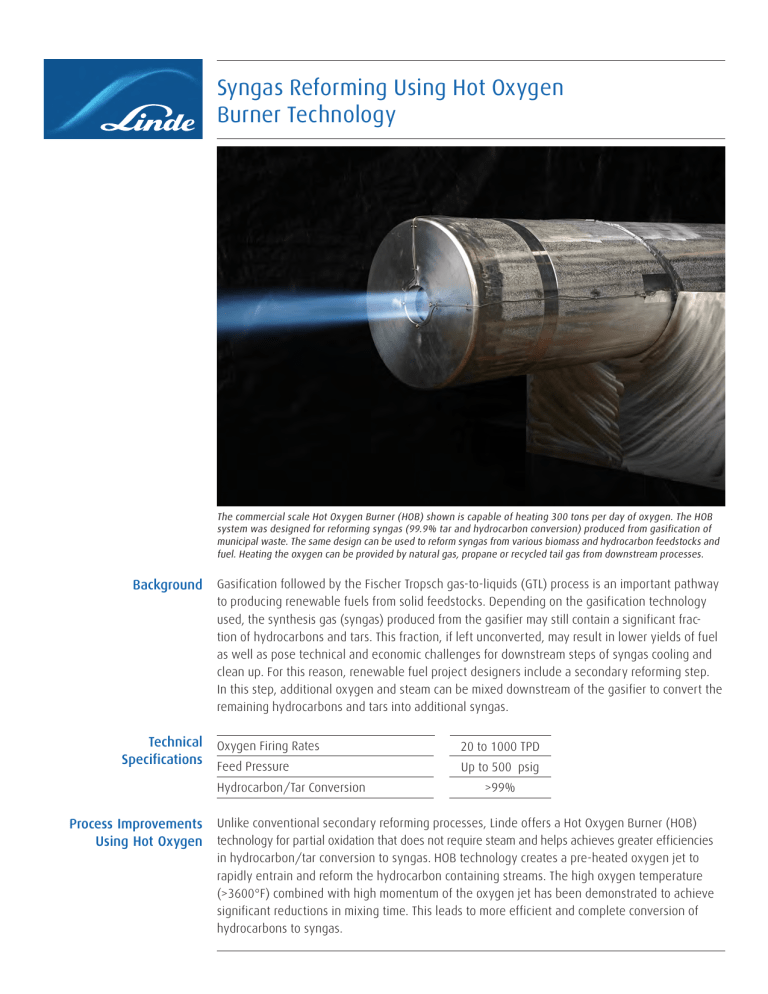
Syngas Reforming Using Hot Oxygen Burner Technology The commercial scale Hot Oxygen Burner (HOB) shown is capable of heating 300 tons per day of oxygen. The HOB system was designed for reforming syngas (99.9% tar and hydrocarbon conversion) produced from gasification of municipal waste. The same design can be used to reform syngas from various biomass and hydrocarbon feedstocks and fuel. Heating the oxygen can be provided by natural gas, propane or recycled tail gas from downstream processes. Background Technical Specifications Gasification followed by the Fischer Tropsch gas-to-liquids (GTL) process is an important pathway to producing renewable fuels from solid feedstocks. Depending on the gasification technology used, the synthesis gas (syngas) produced from the gasifier may still contain a significant fraction of hydrocarbons and tars. This fraction, if left unconverted, may result in lower yields of fuel as well as pose technical and economic challenges for downstream steps of syngas cooling and clean up. For this reason, renewable fuel project designers include a secondary reforming step. In this step, additional oxygen and steam can be mixed downstream of the gasifier to convert the remaining hydrocarbons and tars into additional syngas. Oxygen Firing Rates Feed Pressure Hydrocarbon/Tar Conversion Process Improvements Using Hot Oxygen 20 to 1000 TPD Up to 500 psig >99% Unlike conventional secondary reforming processes, Linde offers a Hot Oxygen Burner (HOB) technology for partial oxidation that does not require steam and helps achieves greater efficiencies in hydrocarbon/tar conversion to syngas. HOB technology creates a pre-heated oxygen jet to rapidly entrain and reform the hydrocarbon containing streams. The high oxygen temperature (>3600°F) combined with high momentum of the oxygen jet has been demonstrated to achieve significant reductions in mixing time. This leads to more efficient and complete conversion of hydrocarbons to syngas. Syngas Reforming Using Hot Oxygen Burner Technology Benefits In addition to potentially higher yields, HOB Technology provides several key benefits to syngas secondary reforming processes when compared to conventional processes: → Enables simpler and more flexible partial oxidation reactor design → Enhanced uptime for processes downstream of gasifier → Accelerated system start-ups → Reduced soot formation → Operational stability with varying feed gas composition → Does not require fired heaters; minimizes NOx and CO2 emissions → Greater flexibility to process various feedstocks including off-gases, coke oven gas, natural gas, and other hydrocarbon streams Features → Oxygen Supply → Hot Oxygen Burner (HOB) and flow control skids → Design services for syngas inlet Summary 2 of 2 HOB Technology is a preferred method for reforming of hydrocarbon- containing waste streams delayed coking unit off-gases, coke oven gas, and waste gas steams from iron reduction processes in steel manufacturing. Reforming is also required by processors seeking to biologically convert syngas streams to alcohols and other liquid chemicals. Diagram: Hot Oxygen Burner Technology Crude Syngas Fuel → Biomass Gasifiers → Refinery Fuel Gases HOB Technology Linde O2 Supply → Coke Oven Gas → Iron Reduction Simplified POx REactor Higher Yield Syngas (>99% HC/Tar Conversion) Contact Linde Today Linde works hard to provide our customers with advances in application technology and reliable industrial gas supply. For more information, please contact us to learn more about how we can help you improve your gasification and syngas production needs. Call us at 1-844-44LINDE or visit www.lindeus.com. Linde 10 Riverview Drive Danbury, CT 06810 Phone 1.844.44LINDE (1.844.445.4633), Fax 1.800.772.9985; 716.879.2040 www.linde.com The Linde logo and the Linde wordmark are trademarks or registered trademarks of Linde plc or its affiliates. The information contained herein is offered for use by technically qualified personnel at their discretion and risk without warranty of any kind. Copyright © 2020, Linde plc. 1/2020 P-40-4561





